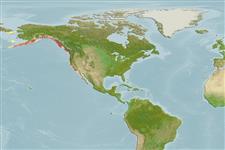Common names from other countries
Classification / Names / Names
Common names | Synonyms | Catalog of Fishes (gen., sp.) | ITIS | CoL | WoRMS
Environment: milieu / climate zone / depth range / distribution range
Ecology
Benthic; depth range 0 - 50 m (Ref. 95344). Temperate
Eastern Pacific: Alaska, Canada, USA. Subtropical to boreal.
Length at first maturity / Size / Weight / Age
Maturity: Lm ? range ? - ? cm Max length : 14.0 cm SHH male/unsexed; (Ref. 95344)
Found on sand along the intertidal zone to 50 m depth (Ref. 95344).
Life cycle and mating behavior
Maturity | Reproduction | Spawning | Eggs | Fecundity | Larvae
Members of the order Neotaenioglossa are mostly gonochoric and broadcast spawners. Life cycle: Embryos develop into planktonic trocophore larvae and later into juvenile veligers before becoming fully grown adults.
Birkeland, C. 1974. (Ref. 94088)
IUCN Red List Status (Ref. 130435)
CITES status (Ref. 108899)
Not Evaluated
Not Evaluated
Human uses
| FishSource |
Tools
More information
Age/Size
Growth
Length-weight
Length-length
Morphology
Larvae
Abundance
Internet sources
Estimates based on models
Preferred temperature
(Ref.
115969): 8.6 - 12.8, mean 10.2 (based on 60 cells).
Price category
Unknown.
